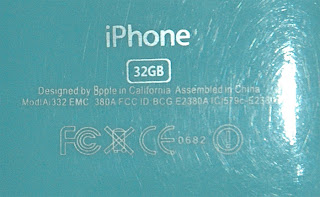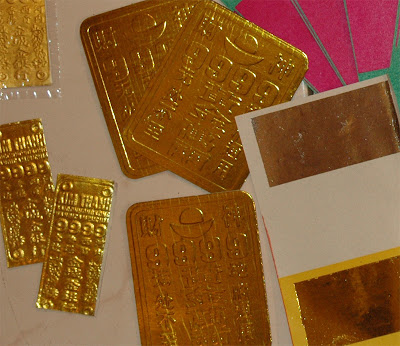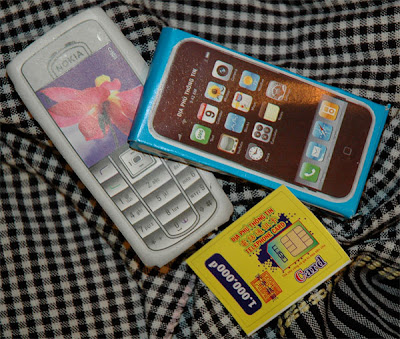Last Monday (August 14th) was the 'Hungry Ghost Festival' (中元節 / 中元节 / Tết Trung Nguyên), a Chinese holiday not officially observed here in Cambodia but still kept amongst the country's Chinese, Chinese-Khmer and Vietnamese communities. My neighbors here in Phnom Penh were burning joss paper on the sidewalk several times that day and had me over to take a few photos for them.
Celebrated on the 15th day (half-moon) of the seventh month of the Chinese lunar calendar, the
Hungry Ghost Festival is the Chinese version of the Khmer
P'chum Benh, that time of year the gates of the underworld are opened and the spirits released to roam the Earth, if only briefly. During this period the living (at least the Chinese and Vietnamese ones) make offerings to these souls at the pagoda and at home, both to aid and appease their ancestors, as well as other loosened spirits.
In one of the most apparent manifestations of the festival, believers burn joss paper and place offerings to the spirits on tables and blankets in front of their homes - on the sidewalk, the balcony, porch or just inside the open gates.
The spread of offerings is often centered on a roasted red pig, candles and burning incense, and may include things such as rice, sugar, fruit, drinks, candy, cigarettes, snacks, etc. Apparently the afterworld is similar to this one and the idea is to provide for the welfare of the deceased to help ensure a comfortable afterlife. Providing for their financial needs, joss paper, including 'ghost money' is burned, the process sending it to the dead for use as ghostly tender.
Traditionally, joss paper offerings were gold and silver colored paper and later stylized Chinese currency ('ghost money.') It could also include paper representations of clothing, fabric, houses and other practicalities. But times change. As the neighbor showed me the various joss offerings he was preparing for the fire I discovered that 21st century ghosts get to enjoy the niceties of modern consumerism and even the trappings of
conspicuous consumption, not unlike Phnom Penh's upper crust of 2011.
Most of the following are examples the various joss items my neighbor had on hand. Most of the interpretations of what they represent come from my Chinese-Khmer neighbors, who were not in complete agreement with one another about what it all meant. I am sure it would be easy to get the answers at the market or the pagoda but I haven't followed up.
Gold and Silver
Gold and silver paper, representing the metals, are the most traditional of the joss paper offerings. The gold paper is intended for ancestors and the gods. The silver is meant for ancestors exclusively.
Traditional gold and silver joss paper. Smooth gold and silver leaf or paint on coarse bamboo paper. 9cm x 14cm.
Gold joss paper at the market. Phsar Oreussey, Phnom Penh
Gold ingots and coins. Printed on light newsprint paper.
Left and center: Modern gold bullion bars, .9999 pure. Made of light cardboard, embossed. No printing.
Right: Silver and gold on bamboo paper.
Gold bullion bars, .9999 pure. Made of light cardboard, embossed. Left in Vietnamese. Right in Chinese..
There was some debate about this one - coins or a fabric with pattern. Most felt it was coins. Printed on reclaimed paper or scrap paper from print houses, often old newspapers and office materials. Many of these had the old Cambodia Dailys on the reverse.
Currency (copper)
Classic 'ghost money,' i.e. ghost currency/bank notes, has been used since at least the 19th century AD. It is usually denominated in Chinese Yuan, often in absurdly large denominations, and sold in bundled stacks. The face of the note very often sports a portrait of the
Jade Emperor, and the reverse an image of the 'Bank of Hell.' The note is often signed by the Jade Emperor and the
King of Hell (Yan Wang/Yanluo.) Ghost money is said to be 'copper' as differentiate from gold and silver that is sent to ancestors. It is meant for use by the more recently dead (as opposed to distant ancestors) and other relatives and as an offering (if not better termed a bribe) to the Judge of the Dead (also Yan Wang.)
The use of the English word 'Hell' in e.g. the 'Bank of Hell' and 'Hell Money' is probably an imperfect reference to the underworld and the court of the dead. Upon death, all souls, regardless of their merit or lack thereof, are first sent to the underworld where their eternal fate is determined by the judge Yan Wang. The ghost money is intended, in part, as a gratuity of sorts to the judge in the hope that he will adjudicate their ancestors case favorably and/or lighten the length of their stay in the underworld. My neighbor, in trying to explain it to me, smiled wryly and called it "
corruption money for God."
These are a few examples the neighbor happened to have on hand.
100 yuan note. Jade Emperor on front. The Bank of Hell on the reverse.
Joss money with dragon on the front and Bank of Hell on the reverse.
10,000,000 yuan note. Hell Bank note. Jade Emperor on front with signatures of Jade Emperor and the King of Hell. The Bank of Hell on the reverse.
1,000,000,000,000 yuan note. Jade Emperor on front. The Bank of Hell on the reverse.
100,000,000,000 yuan note. Jade Emperor on front with signatures of Jade Emperor and the King of Hell. The Bank of Hell on the reverse.19cm x 43 cm.
20 baht note for those traveling in the Thai quarter of the Hereafter. The design on the front is loosely based on a new style Thai 20 baht note, with '20' in Thai script.
50,000 dong for those in the Vietnamese section of the afterworld. Jade Emperor on front and the Bank of Hell on the reverse. The design of the bill seems loosely based on US currency.
Perhaps the most common non-Chinese ghost money, the US$100 is still the universal currency even in the Hereafter. A pretty good replica of a US$100, though the paper and the print quality is far inferior to even the crudest counterfeit bills. The only design difference from a real US$100 is on the reverse where 'United States of America' has been replaced by 'Abode of the Dead Bank,' which is presumably a reference to the underworld as the word 'Hell' on other notes.
50 Euro note. Jade Emperor on face.
Ghost money at the market. Phsar Oreussey, Phnom Penh
Clothes and fabric
Joss paper clothing and fabric seems to be the next most common paper offering. Some of the clothing paper contained other symbols (cups, hat?, boat? cups, ect.) about which my neighbors could not agree on the meaning.
Clothing. A set of traditional clothes and a set of modern clothes. Also what appears to be a bell, a vase, drinking cups scissors, a leaf or feather, a hat(?) and a boat (?.) Nobody knew the story behind the cups, scissors, feather, etc. Printed on light newsprint. 16cm x 21cm.
Clothing. A set of traditional clothes and a set of modern clothes. Also what appears to be a bell, a vase, drinking cups scissors, a leaf or feather, a hat(?) and a boat (?.) Nobody knew the story behind the cups, scissors, feather, etc. Printed on light newsprint. 16cm x 21cm.
Clothing. Two sets of traditional clothes. Also what appears to be a bell, a vase, drinking cups scissors, a leaf or feather, a hat(?) and a boat (?.) Nobody knew the story behind the cups, scissors, feather, etc. Printed on light newsprint.16cm x 21cm.
Large pieces of paper fabric. In folded bundles of five different colors. Made of very light crepe paper.
There was some diagreement but most thought this was fabric for making clothes. Made of light crepe paper.
Travel and Banking in the Hereafter
Fold over passport made of Cardboard. Form on the inside with space for name and personal details. Accompanying visa paper in passport. Visa for 'Hell & Paradise.'
Air ticket on the 'Hell & Paradise Airline,' first class of course. 2 parts. Cover and separate passenger detail form.
Bank account book for the 'Bank of Hades and Heaven.' Insert left and cover right, both fold over. The insert is made of light paper. The cover is made of cardboard.
Ghost Vesa Card. Portrait of the Jade Emperor.
Cheque book including blank checks for a ghost account at the 'Bank of Hades - Heaven Main Branch.'

Toiletries, personal items and travel kit for the well-prepared ghost. All made of paper and light cardboard. Slippers, wallet (Adidas) with US$200, iPhone and one million dong cell card, glasses, watch, comb, razor, pen, Zippo lighter and a pack of cigarettes (555 Gold.) The cigarette pack bears no health warnings. Personally, I think this would be one of the greatest benefits of being dead - smoking without fear of health consequences. Unfortunately, next to the mountains of precious metals and stacks of cash being sent to the afterworld , it appears that there are comparatively few cigarettes being forwarded to the dead. If the law of supply and demand holds in the afterworld, gold silver and currency would be in great oversupply, common as paper and probably very cheap, whereas cigarettes would be rare and, if smokers are the same there as here, worth their weight in... well, their weight in gold, so to speak. Wouldn't that be the ultimate rub for the smoker - cigarettes could be enjoyed without adverse health effects, but cost a mountain of gold per pack.
Ghost Bling, Luxury Vehicles and Phones
And for the 21st century ghost, the trappings of a
nouveau riche Phnom Penh lifestyle - black Lexus, iPhone, bling and more.
Ghost car. Black Lexus LX 330 with a Phnom Penh number plate and chauffeur.
Ghost phones and cell card. Nokia and iPhone. Cell card in Vietnamese, 1,000,000 dong. Made of folded cardboard.
Ghost bling. Gold watch (Omega.) Gold bangle. Gold ring. Gold money clip. Gold coins (?.) Gaudy gold necklace. Phone (Nokia). Made of folded and embossed cardboard.
































































